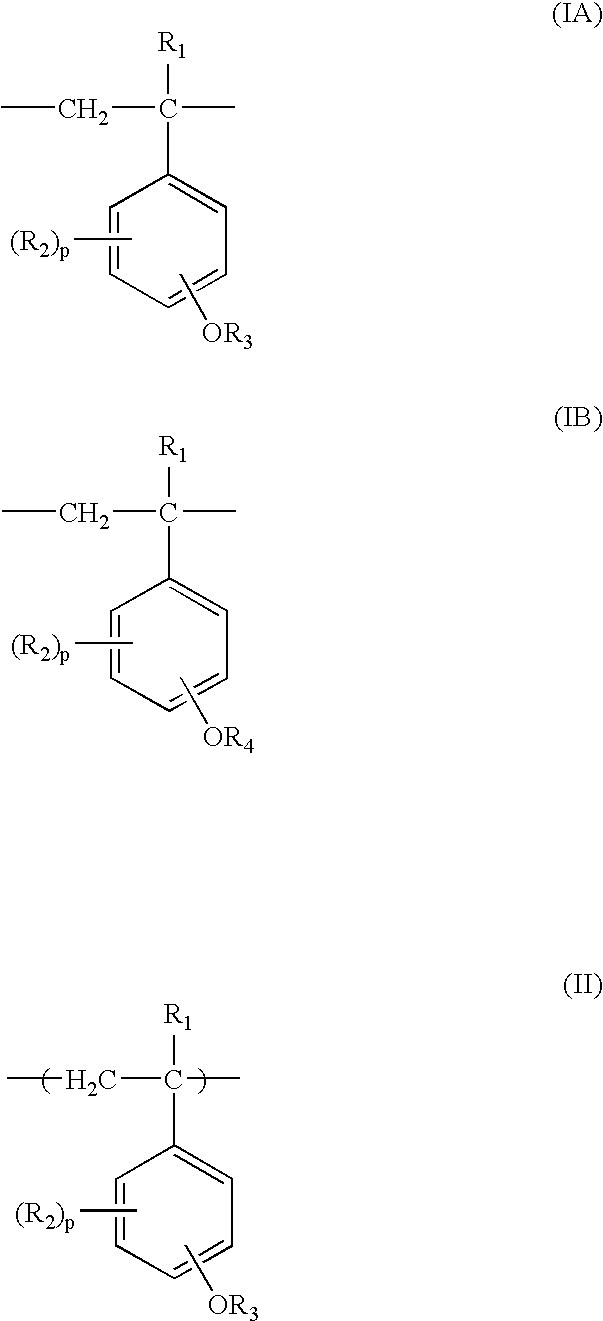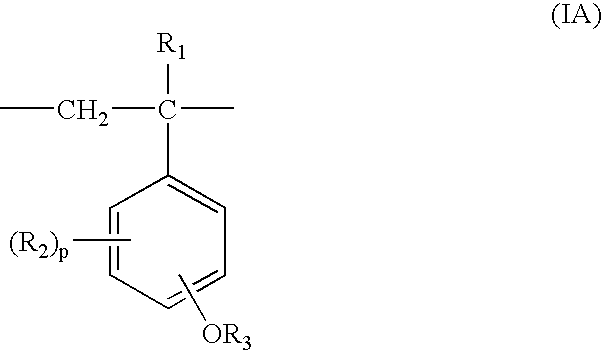Process for production of partially protected poly(hydroxystyrene)s
a technology of polyhydroxystyrene and polystyrene, which is applied in the field of process for the preparation of poly(hydroxystyrene) s, can solve the problems of difficult handling and polymerization control, high self-polymerization of p-hydroxystyrene, and complex synthetic route, and achieves easy control and accurate
- Summary
- Abstract
- Description
- Claims
- Application Information
AI Technical Summary
Benefits of technology
Problems solved by technology
Method used
Image
Examples
example 2
Preparation of Poly(PHS / PTBST Copolymer) with the Degree of Deprotection=60%
100 g of poly-PTBST (Mn=18,000 and Mw / Mn=1.65) synthesized by radical polymerization was dissolved in a mixed solvent of toluene and ethanol at a toluene / ethanol ratio by weight of 1 / 1 to give 270 g of a resin solution of 37% by weight in concentration. (The moisture content of the resin solution was 0.40% by weight.)
The obtained resin solution was raised to a temperature of 60 to 63° C., and 4 g (0.017 moles of sulfuric acid to a mole of tert-butoxy group) of a solution of concentrated sulfuric acid diluted with ethanol at a sulfuric acid / ethanol ratio by weight of 1 / 3 was added. The reaction of Step (1) started. (The moisture content of the reaction system was 0.40% by weight.) When the degree of deprotection reached about 50% 1.5 hours later, 2 g of water was added to the reaction system and the reaction temperature was lowered to 45 to 48° C. to start the reaction of Step (2). (The whole moisture content...
example 3
Preparation of Poly(PHS / PTBST / Styrene Copolymer) with the Degree of Deprotection=75%
100 g of poly(PTBST / styrene copolymer) (Mn=8,500, Mw / Mn=1.08 and styrene content=20% by weight) synthesized by living anion polymerization was dissolved in a mixed solvent of toluene and ethanol at a toluene / ethanol ratio by weight of 1 / 1 to give 333 g of a resin solution of 30% by weight in concentration. (The moisture content of the resin solution was 0.50% by weight.)
The obtained resin solution was raised to a temperature of 55 to 58° C., and 4.8 g (0.035 moles of sulfuric acid to a mole of tert-butoxy group) of a solution of concentrated sulfuric acid diluted with pure water at a sulfuric acid / water ratio by weight of 1 / 2 was added. The reaction of Step (1) started. (The whole moisture content of the reaction system was 1.44% by weight.) It was confirmed 5 hours later that the degree of deprotection reached about 65%. Then, the reaction temperature was lowered to 47 to 50° C. to start the reactio...
example 4
Preparation of Poly(PHS / PTBST / Butyl Methacrylate Copolymer) with the Degree of Deprotection=60%
100 g of poly(PTBST / t-butyl methacrylate) (Mn=8,500, Mw / Mn=1.17 and the content of t-butyl methacrylate is 10% by weight of the block copolymer) synthesized by living anion polymerization was dissolved in a mixed solvent of toluene and ethanol at a toluene / ethanol ratio by weight of 1 / 2 to give 285 g of a resin solution of 35% by weight in concentration. (The moisture content of the resin solution was 0.45% by weight.)
The obtained resin solution was raised to a temperature of 64 to 67° C., and 3 g (0.020 moles of sulfuric acid to a mole of tert-butoxy group in a PTBST unit) of a solution of concentrated sulfuric acid diluted with pure water at a sulfuric acid / water ratio by weight of 1 / 2 was added. The reaction of Step (1) started. (The whole moisture content of the reaction system was 1.14% by weight.) When it was confirmed that the degree of deprotection reached about 45% 2 hours later, ...
PUM
| Property | Measurement | Unit |
|---|---|---|
| Fraction | aaaaa | aaaaa |
| Fraction | aaaaa | aaaaa |
| Percent by mass | aaaaa | aaaaa |
Abstract
Description
Claims
Application Information
 Login to View More
Login to View More - R&D
- Intellectual Property
- Life Sciences
- Materials
- Tech Scout
- Unparalleled Data Quality
- Higher Quality Content
- 60% Fewer Hallucinations
Browse by: Latest US Patents, China's latest patents, Technical Efficacy Thesaurus, Application Domain, Technology Topic, Popular Technical Reports.
© 2025 PatSnap. All rights reserved.Legal|Privacy policy|Modern Slavery Act Transparency Statement|Sitemap|About US| Contact US: help@patsnap.com



